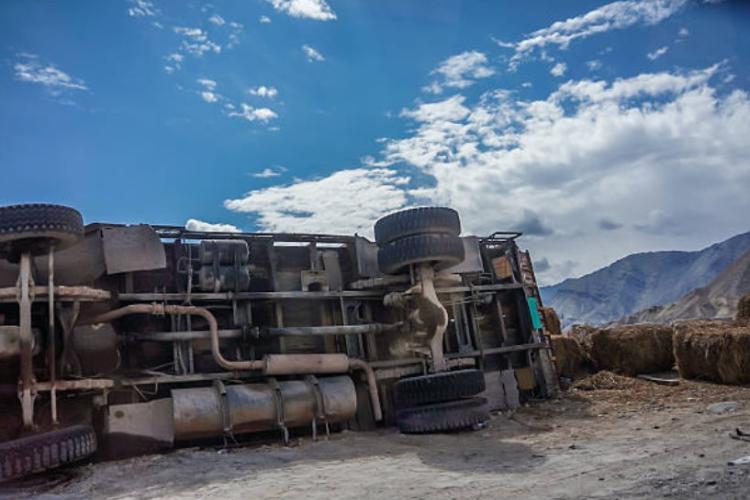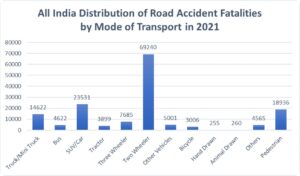
Enhancing road safety in India: Every three to four minutes, India loses another citizen to its roads. Behind the mangled steel and ambulance sirens lurks an even harsher reality: crashes drain an estimated Rs 5.64 lakh crore each year—almost 3% of India’s GDP. This is no mere transportation glitch; it is an unrecognised development emergency, draining the nation of workers, students, families and, ultimately, its future.
Investments in wider highways and splashy awareness drives have not stemmed the carnage. The ministry of road transport and highways (MoRTH) logged 4,61,312 crashes in 2022. They claimed 1,68,491 lives and injured 4,43,366 people—up 12%, 9.4% and 15.3%, respectively, over the previous year. Families are shattered, futures erased and the economy bleeds quietly.
READ | US-India bond yield gap narrows to 1.6%, repricing risk
India now accounts for nearly 11% of global road deaths while owning barely 1% of the world’s vehicles. The World Bank ranks the country among the worst in road safety outcomes, with low‐ and middle-income households bearing the brunt. This silent epidemic strikes precisely the demographic that powers economic growth, straining public services and social-protection schemes alike.
The visible bill: hospitals and highways
Direct costs of road crashes are staggering. Emergency response, trauma care, rehabilitation and property damage quickly pile up. Public hospitals—first port of call for most victims—run chronically overcrowded trauma wards staffed by overstretched doctors and nurses. Treating a single poly-trauma case can cost anywhere from Rs 50,000 to Rs 5 lakh; government health schemes foot much of this bill, further stretching state finances. In rural districts, where insurance coverage is thin, out-of-pocket expenses often push entire families below the poverty line.

Nor is the pain confined to healthcare. Crumpled guardrails, smashed signage and wrecked government vehicles demand constant repair. Each reconstruction job diverts scarce public money from new infrastructure towards patching up the old.
Direct costs — Public health and fiscal drain
Yet the larger hit rarely shows up in budget documents. More than 83% of crash victims fall between 18 and 60—prime working years. A single fatality wipes out decades of potential earnings. An IIT Delhi study pegs the median economic loss of each death at about Rs 91 lakh, while a grievous injury costs Rs 3.6 lakh. Factor in lifelong productivity losses and informal caregiving, and the burden of a serious injury balloons to Rs 15–20 lakh.
For households, the spiral is vicious: breadwinners vanish, children drop out of school, and women retreat from paid work to provide care, deepening gender gaps. For the wider economy, absenteeism, disrupted supply chains and higher insurance premiums erode competitiveness—particularly in logistics-heavy sectors such as agriculture, e-commerce and construction.
Indirect costs — Human capital and productivity
Road crashes reverberate far beyond transport. Take insurance: motor and medical claims are pushing premiums higher for everyone. In 2023-24, the Insurance Regulatory and Development Authority of India reported net incurred claims across the non-life sector at Rs 1.72 lakh crore, up more than 15% year-on-year. Motor policies remain the biggest slice, driven by the sheer frequency and severity of crashes.
Education suffers when children become caregivers or lose fee-paying parents. Urban planning suffers when fear keeps pedestrians off footpaths and cyclists off the road. Labour markets suffer when skilled workers never return to the shop floor.
Investment in road safety
The grim ledger makes a compelling fiscal case for prevention, yet public spending tells a different story. In 2022-23, MoRTH earmarked just Rs 356 crore—less than 0.2% of its budget—for road-safety initiatives. Compare that with the United States, which will direct roughly 6% of its highway outlay—$3.4 billion (Rs 27,000 crore)—to its Highway Safety Improvement Program this year.
The parliamentary standing committee on transport and NITI Aayog have, time and again, urged that at least one-tenth of MoRTH’s annual envelope be reserved for maintenance and safety. Better road design, stricter enforcement and comprehensive driver training would pay for themselves many times over.
Road safety — a pillar of development strategy
Global evidence is clear. Sweden’s Vision Zero strategy cut fatalities by half in two decades; Australia’s black-spot programmes deliver benefits worth four to five times their cost. Similar returns await India if it moves decisively: think median barriers on divided highways, mandatory crash-test ratings for vehicles and data-driven policing that targets speeding and drunken driving hot spots.
At over Rs 5.6 lakh crore a year, the price of complacency is colossal—measured not only in lost GDP but also in broken homes and blighted dreams. For a nation aspiring to a $5 trillion economy, slashing road deaths is not a peripheral agenda item; it is central to inclusive and sustainable growth.
Road safety deserves to stand alongside education, health and climate adaptation as a pillar of development policy. Anything less reduces the Amrit Kaal promise to an empty slogan—spoken over the din of sirens on yet another stretch of tarmac gone deadly.
Bipul Chattopadhyay is Executive Director, and Amrat Singh, Director at CUTS International.
